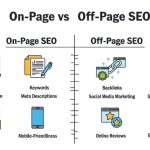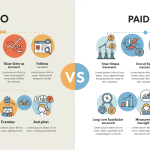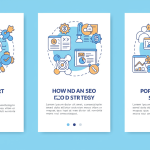
E-commerce businesses face unique SEO challenges that traditional websites don’t encounter. With thousands of product pages, complex site structures, and fierce competition for commercial keywords, ranking your online store requires a specialised approach.
The stakes are high: 53% of all website traffic comes from organic search, and e-commerce sites that appear on the first page of search results capture 92% of all traffic. Yet many online retailers struggle with common SEO pitfalls—duplicate content across product variations, thin category descriptions, and poor site architecture that confuses both users and search engines.
This guide breaks down 11 actionable SEO strategies specifically designed for e-commerce websites. You’ll discover how to optimize product pages for maximum visibility, structure your site for better crawling, and implement technical fixes that can dramatically improve your search rankings and drive more qualified traffic to your store.
Optimize Product Pages for Search Intent

Product pages are the foundation of e-commerce SEO success. Each page should target specific keywords that match how customers search for your products.
Start by conducting keyword research for each product category. Use tools like Google Keyword Planner or SEMrush to identify high-volume, commercial-intent keywords. Look for phrases that include buying signals like “buy,” “best,” “review,” or “price.”
Create unique, detailed product descriptions that naturally incorporate your target keywords. Avoid manufacturer descriptions that appear on dozens of other websites. Instead, write original content that highlights benefits, addresses common questions, and includes relevant keywords in the first 100 words. Learn why partnering with SEO experts is a game-changer for your business: Business Needs SEO Consulting (And How to Choose the Right Partner)
Optimize your product titles with a clear hierarchy: Brand + Product Name + Key Features + Model Number. This structure helps both search engines and customers understand exactly what you’re selling.
Implement Strategic Internal Linking
Internal linking helps search engines discover and understand your site structure while distributing page authority throughout your website. For e-commerce sites, this means creating clear pathways between categories, subcategories, and individual products.
Use descriptive anchor text that includes relevant keywords. Instead of “click here” or “view product,” use phrases like “organic cotton t-shirts” or “waterproof hiking boots.” This approach signals to search engines what the linked page is about.
Create hub pages that link to related products and categories. For example, a “Men’s Athletic Wear” category page should link to subcategories like running shorts, workout shirts, and athletic shoes, while also featuring links to popular individual products.
Implement breadcrumb navigation to show users and search engines the relationship between pages. This simple addition can improve both user experience and crawlability.
Solve Technical SEO Fundamentals
E-commerce websites often struggle with technical issues that can severely impact search rankings. Address these common problems to ensure search engines can properly crawl and index your site.
Fix duplicate content issues that arise from product variations, faceted navigation, and URL parameters. Use canonical tags to point search engines to the preferred version of pages with similar content. For products with multiple color or size options, canonicalize variation pages to the main product page.
Optimize your site speed, as page loading time directly affects both search rankings and conversion rates. Compress images, minimize CSS and JavaScript files, and consider using a content delivery network (CDN) to serve files faster to users worldwide.
Ensure your website is mobile-responsive. Google uses mobile-first indexing, meaning it primarily uses the mobile version of your site for ranking purposes. Test your site on various devices and fix any mobile usability issues.
Create SEO-Optimized Category Pages
Category pages often have the highest ranking potential for competitive commercial keywords, yet many e-commerce sites treat them as afterthoughts with thin content and poor optimization.
Write comprehensive category descriptions that go beyond simple keyword stuffing. Create 300-500 words of valuable content that explains the product category, highlights key features customers should consider, and naturally incorporates relevant keywords.
Use proper heading structure with H1 tags for category names and H2 tags for subcategory sections. This hierarchy helps search engines understand your content organization.
Include customer reviews and ratings on category pages when possible. User-generated content adds fresh, relevant text that search engines value while building trust with potential customers.
Leverage Schema Markup for Rich Snippets
Schema markup helps search engines understand your content and can trigger rich snippets that make your listings stand out in search results.
Implement product schema markup to display star ratings, prices, and availability directly in search results. This enhanced listing format can significantly improve click-through rates and drive more qualified traffic.
Add review schema to showcase customer ratings and review counts. Products with visible star ratings often see 15-35% higher click-through rates compared to standard listings.
Use organization schema to help search engines understand your business information, including location, contact details, and social media profiles. This markup can improve your chances of appearing in local search results and knowledge panels.
Build Authority Through Content Marketing
Content marketing serves dual purposes for e-commerce SEO: attracting backlinks that boost domain authority and creating entry points for customers who aren’t ready to purchase immediately.
Create buying guides, comparison articles, and how-to content related to your products. For example, a sporting goods store might publish “How to Choose the Right Running Shoes” or “Trail Running vs. Road Running: Complete Gear Guide.”
Develop seasonal content that targets high-volume keywords during peak shopping periods. Holiday gift guides, summer fashion trends, or back-to-school shopping lists can capture traffic during crucial selling seasons.
Guest posting on relevant industry blogs and publications can earn valuable backlinks while establishing your brand as an authority in your niche. Focus on providing genuine value rather than purely promotional content.
Optimize for Local SEO (If Applicable)
E-commerce businesses with physical locations or local service areas should implement local SEO strategies to capture nearby customers.
Create and optimize Google My Business listings with accurate business information, photos, and regular updates. Encourage satisfied customers to leave reviews, as positive ratings can improve both local search rankings and conversion rates.
Build location-specific landing pages if you serve multiple geographic areas. Include local keywords, area-specific content, and contact information for each location.
Earn citations from local directories and industry-specific listings. Consistent NAP (Name, Address, Phone) information across all platforms helps search engines verify your business’s legitimacy.
Monitor and Improve Site Architecture
Clear site architecture helps search engines crawl your website efficiently while making it easier for customers to find products.
Keep your URL structure clean and logical. Use descriptive URLs that include relevant keywords: /mens-running-shoes/nike-air-max-270 is better than /product/12345.
Implement faceted navigation carefully to avoid creating excessive duplicate content. Use robots.txt files or noindex tags to prevent search engines from indexing filtered result pages that don’t add unique value.
Create an XML sitemap that includes all important pages and submit it to Google Search Console. Update your sitemap regularly as you add new products or categories.
Track Performance and Iterate
Successful e-commerce SEO requires ongoing monitoring and optimization based on performance data.
Use Google Analytics and Google Search Console to track organic traffic, keyword rankings, and conversion rates. Identify pages that receive traffic but have low conversion rates—these may need better optimization or more compelling product information.
Monitor your competitors’ SEO strategies using tools like Ahrefs or SEMrush. Identify keywords they rank for that you don’t, and look for content gaps you can fill.
Conduct regular technical SEO audits to catch issues before they impact your rankings. Check for broken links, slow-loading pages, and crawl errors that could hurt your search performance.
Focus on User Experience Signals

Search engines increasingly factor user experience metrics into their ranking algorithms. Pages that provide excellent user experiences tend to rank higher over time.
Optimize your site navigation to help users find products quickly. Implement robust search functionality with filters, auto-complete, and typo tolerance.
Ensure your checkout process is streamlined and secure. High bounce rates on product and cart pages can signal to search engines that users aren’t finding what they expect.
Test different page layouts and elements to improve engagement metrics like time on page and pages per session. These behavioral signals can indirectly impact your search rankings.
Building Long-Term E-commerce SEO Success
E-commerce SEO is not a one-time project but an ongoing process that requires consistent effort and adaptation. The strategies outlined in this guide provide a solid foundation, but success comes from implementing them systematically and measuring results.
Start by addressing technical SEO issues and optimizing your highest-traffic product and category pages. Once these fundamentals are in place, expand into content marketing and link building to boost your domain authority.
Remember that SEO results take time, especially for competitive e-commerce keywords. Focus on creating genuine value for your customers through detailed product information, helpful content, and excellent user experience. These efforts will compound over time, leading to sustainable organic growth that drives long-term business success.


















No Comments